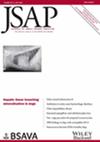A retrospective analysis of postoperative gastrointestinal dehiscence and ileus in dogs receiving carprofen or not receiving carprofen following gastrointestinal surgery
Abstract
Objectives
To investigate the relationship between nonsteroidal anti-inflammatory drugs and the occurrence of gastrointestinal dehiscence and ileus in dogs following gastrointestinal surgery.
Study Design
Retrospective cohort study.
Materials and Methods
Seven hundred and twenty-one dogs had surgery related to foreign body obstruction between January 2009 and December 2020. Records were reviewed and postoperative NSAID administration, ileus, and gastrointestinal dehiscence were recorded. The data were then analyzed for any correlation between age, surgical procedure, NSAID administration, and occurrence of gastrointestinal dehiscence or ileus postoperatively.
Results
69/721 dogs received carprofen. The distribution by surgery type for dogs receiving carprofen was 43/307 for gastrotomy, 11/216 for enterotomy, and 15/198 for enterectomy. A total of 199 dogs experienced ileus, and 13 dogs experienced intestinal dehiscence. 18/199 dogs that experienced ileus received carprofen, and 0/13 dogs that experienced dehiscence received carprofen. No difference in the occurrence of ileus or intestinal dehiscence was observed for dogs receiving carprofen. The odds of developing postoperative ileus increased by 53% (OR = 1.53, 95% CI: 1.065 to 2.209) for an enterectomy in comparison to a gastrotomy or enterotomy. The odds of developing postoperative ileus increased by approximately 10% for every year increase in age. The odds of dehiscence increased 6.2 times for an enterectomy in comparison to a gastrotomy or enterotomy; however, age and carprofen had no effect on the rate of dehiscence.
Clinical Significance
Carprofen did not significantly increase the risk of intestinal dehiscence and can be considered part of multimodal pain control following gastrointestinal surgery with appropriate patient selection.

 求助内容:
求助内容: 应助结果提醒方式:
应助结果提醒方式:


